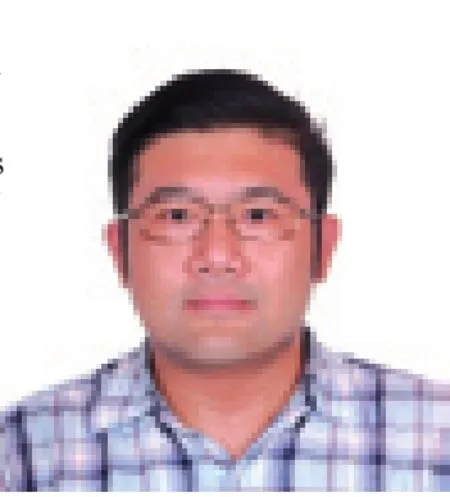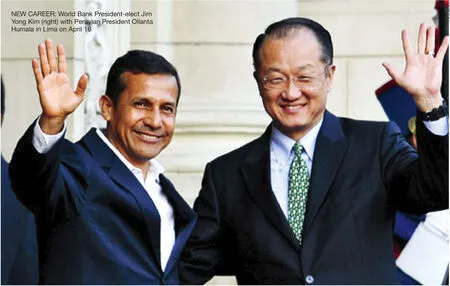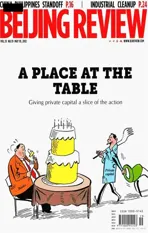New Look for the World Bank
2012-10-14NewWorldBankpresidentcouldmakethebankmoredevelopmentorientedByWeiLiang
New World Bank president could make the bank more development-oriented By Wei Liang
New Look for the World Bank
New World Bank president could make the bank more development-oriented By Wei Liang

The author is an assistant research follow with the Institute of World Economic Studies at the China Institutes of Contemporary International Relations
The World Bank appointed a new president on April 16. Jim Yong Kim, who was born in Seoul, South Korea, in 1959, is going to officially replace current World Bank President Robert Zoellick on July 1 and become the 12th president of the bank. The world is hoping the new president can help the World Bank take on a new look.
Qualified nominee
Kim, who is president of Dartmouth College, is an experienced expert on public health and an anthropologist. He is one of the founders of Partners in Health. He was in charge of the World Health Organization’s project to offer HIV/AIDS prevention assistance to the least developed countries. But Kim has no experience in economic and financial fields, which is why some are concerned about his appointment.
Although its official name is the World Bank, the bank has more functions than financing. So its president is expected to have a strong background in international organizations, be good at communication, management and coordination, have the sincerity of helping poor countries and understand developing countries’ desperation for development. These are more important than just an economic and financial background, because the president of the World Bank is the manager of a multilateral institute aimed at promoting world development.
A qualified World Bank president should be able to utilize all kinds of personnel, including politicians, economists, sociologists, anthropologists and international observers. In terms of helping the least developed nations, Kim is more suitable than economists who know only economic theories. If the World Bank continues to select senior executives with a focus on development, the reform of its governance structure will be advanced.
Changing times
For a long time, the World Bank president has been under U.S. control, and usually has work experience in Wall Street or the U.S. Government. Therefore, past World Bank presidents always brought their experience in government and financial companies into their new job. As a consequence, the World Bank has focused more on maintaining U.S.-led financial order than on development and poverty reduction. The Washington Consensus, which overstresses liberalization, marketization and privatization and was designed to be suitable for all countries, represents the existing World Bank style.
While forcing the world to adjust its economic and financial systems, the global financial crisis and the sovereign debt crisis have hindered progress in fulfilling the UN’s Millennium Development Goals. The excessive liberalization advocated by the Washington Consensus is causing problems for both developing and developed countries, prompting the world to rethink the past development path and philosophy.
Kim will be the first World Bank president without a background in Wall Street or the U.S. Government. His appointment shows the World Bank has started to correct its flawed practices. However, the old pattern that has existed for nearly 70 years is hard to break. The new president is still nominated by the U.S. president. Developed countries retain their dominance in the World Bank, and developing nations’ voices are weak and disunited. A new face is not enough to change the old thinking.
The new World Bank president remains under the control of the invisible hand of the old World Bank structure. Perhaps Kim will introduce new initiatives on promoting global development. But it is still difficult to drastically change the World Bank’s management philosophy and development plan.
The World Bank president has been an American ever since the bank was established in 1945. The United States takes a dominant position in the World Bank. This tradition reflected the international economic structure when the World Bank and the International Monetary Fund (IMF) were set up. It is also a way that the United States and Europe are interdependent. The World Bank membership has changed along with changes in the global economic structure. Its function also has switched to promoting development of less developed countries from its original focus on reviving Europe. But its governance structure hasn’t changed with time. Mutual help between Europe and the United States has become shared governance. Also, members’status in the World Bank has become unequal given the different shares they hold in the bank’s capital stock.
Previously, the World Bank and the developing countries it helped were at an equal position. Now the developing countries have become followers of the World Bank, and even have to give up some of their sovereignty for the bank’s projects and assistance. Emerging economies’ position in the global economy has risen since the global financial crisis, and their voices are getting louder in international economic and financial organizations. Therefore, reforming the World Bank’s equity and governance structures is on the agenda. The World Bank adjusted its equity structure in 2010, when developing countries’ position was raised, bringing initial changes to the organization.
The nomination of Kim as the next World Bank president reflects developed countries’further compromise. It may help U.S. President Barack Obama gain more votes from Asian Americans. More importantly, it shows the United States has begun to rethink the governance of international economic organizations against the backdrop of changing international economic and political landscapes.

As Western dominance appears poised to decline, the World Bank will be able to treat all countries equally and truly reflect the balance of power between developed and developing economies
Right direction
Since former IMF Managing Director Dominique Strauss-Kahn’s resignation in May last year, emerging economies and developing countries have nominated their own candidates for the top jobs of the IMF and the World Bank, a positive change in the leadership selection of the two international financial institutions. Facing competition from emerging economies, the United States and Europe have started to take measures to sustain the current system. The nomination of Kim, an academic with extensive engagement with developing countries, showed the compromise the United States had made to protect its interests in the World Bank. The cost, however, will get bigger and bigger until the United States and all developed countries cannot stand. As Western dominance appears poised to decline, the World Bank will be able to treat all countries equally, abandon the practice of appointing governance personnel according to developed countries’ favoritism, and truly reflect the balance of power between developed and developing economies. By then, there might be a World Bank president born and educated in a developing country and appointed based on his or her merits.
Over the past decades, the World Bank’s function has enlarged and its major target has changed. The future blueprint of the World Bank should also advance with the times. The World Bank should rethink its role and position in the 21st century. Currently, the primary goal of the World Bank is helping the least developed countries out of poverty and starvation, on which the World Bank has made some efforts in the past 30 years. But the latest crisis shows development is much more than conquering poverty, starvation and diseases. Some Western countries like Greece are trapped in a debt crisis and their economic, political and social situations are even worse than rapidly growing emerging markets. So developed countries, like developing countries, may also need the World Bank’s assistance.
The World Bank’s new president must reposition the organization’s priorities and form a new development plan. The complicated global situation requires the World Bank to uphold the principles of inclusiveness, sustainability and diversity when helping solve the development problems of countries with different national conditions and at different development levels. Kim is expected to steer the World Bank in that direction.
